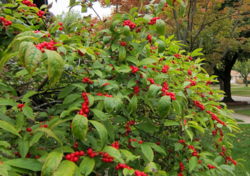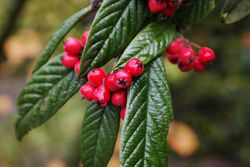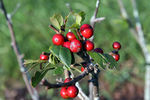Common winterberry
| Common winterberry |
|---|

|
| Scientific Classification |
|
| Scientific Name |
|
Ilex verticillata |
| Ilex verticillata |
The Common Winterberry is a species of holly that is known by the scientific name Ilex verticillata. They are native to eastern North America in the United States and southeast Canada, from Newfoundland west to Ontario and Minnesota, and south to Alabama.[1]
Other names that have been used include black alder winterberry, brook alder, Canada holly, coralberry, deciduous holly, deciduous winterberry, false alder, fever bush, inkberry, Michigan holly, possumhaw, swamp holly, Virginian winterberry, or winterberry holly.[2]
The species occurs particularly in wetland habitats, but also on dry sand dunes and grassland. The berries are an important food resource for some species of bird, among them the American robin.[3]
Body Design
The common winterberry is a shrub that can grow from 5 to 15 feet tall. The color of the shrubs bark ranges from a gray to a blackish color. The leaves of the plant are 1 1/2 to 4 inches long. They are a dark green color in the summer and a bright yellow color in the fall.[4]The fruit grown of the shrub are bright red berries. They produce unripened berries in the summer and are a light green. During the winter they are a bright red berry.[5]The berry is 1/4 inches in diameter and occur in singles or pairs. Each berry contains 3 to 5 nutlets which are very small nuts.[6]There fruits are used for ornamental purposes and are attracted by both birds and butterflies for its tasty fruit.[7]There are greenish to yellowish white flowers that bloom on the plant between April through July after the leaves have grown. This flower is attracted by many wildlife creatures. The flowers quickly vanish due to the animals feeding off of them.[8]
Life Cycle
The winterberry does not require both male and female plant. You need at least one in the area to reproduce red berries. Once a female plant is fertilized then she will be able to reproduce. The male does not exactly reproduce but it produces adequate pollen and can produce up to 10 male plants.[9]When the animals eat the plant it actually helps with their reproduction. By cedar waxing and other creatures, this helps the seeds disputer and reproduce.
How to tell the male and female winterberry apart is seeing weither or not the flowers on the shrub are pollinated. The male flowers are different from the female flowers. They both have four petals which does not help with comparing them, but the center of the flower does. The male flower has four yellow stamens. The female has a green ovary center.[10]
Another way of reproduction is by the seed. once the seed is dropped into the ground, they ferment and the seeds readily germinate. Birds are also a help to this process. If birds eat of the berries the may sometimes and disperses them as they go. To get the best result of growth if you are wanting to grow a winterberry plant in your very own yard is by stem or root cutting. By doing this the plants fruit will mature sooner than by growing from the seed.[11]
Ecology
The winterberry serves its purpose well in northern climes. Ilex verticillata is a wet site indicator species, and almost always grows on the margins of wetlands and lakeshores. There its mercurochrome colored berries flag down the passing birds as they continue southerly from the boreal forest to regimes well beyond our southern states' habitats, even as far as the Caribbean and beyond.[12]
It usually grows wild in moist, boggy areas. The shrub adapts easily to the home landscape, where it reaches heights and widths of 6 to 12 feet, depending on the variety. Although the plant adapts to most soil conditions, winterberry thrives in soil that is rich with organic material. Winterberry generally requires no fertilizer.[13]
Pouisonus
The winterberries leaves, seeds, bark and berries are all toxic to humans, though the greatest concentration of alkaloids are in the berries. The berries contain an alkaloid called Theobromine that is almost identical to the caffeine found in coffee and tea, according to the Nova Scotia Museum. Large quantities of Theobromine can cause symptoms similar to a "caffeine overdose," such as dizziness, nausea, diarrhea, stomach pain, an elevated pulse or drowsiness. All species of holly plants contain toxic alkaloids.[14]
Winterberry is poisonous to pets such as cats, dogs and horses, according to the ASPCA, though the organization notes that the toxicity of leaves and berries is low. Symptoms of winterberry poisoning in pets can include vomiting, diarrhea and depression. If you suspect your pet has ingested part of a winterberry plant, contact your veterinarian or call the ASPCA Animal Poison Control Center at 888-426-4435. Paws Dog Daycare states that ingesting winterberries very rarely results in a life-threatening situation.[15]
Proper planning keeps winterberries safely away from humans and pets that could be harmed. Select garden spots that restrict access to unsupervised children and pets. Keep fallen leaves and berries cleaned up from the ground to prevent accidental ingestion. Caffeine is the primary toxic ingredient in winterberry, and symptoms can be unpleasant. Humans with severe, prolonged reactions to winterberry ingestion should be evaluated by medical professionals. Animals that show symptoms of winterberry poisoning should be seen by their veterinarian. Take a sample of the plant to the doctor or veterinarian to aid in proper identification and diagnosis.[16]
Video
References
- ↑ [1] Ilex verticillata. Web. last modified: Febuary 3, 2018.
- ↑ Authorlastname, Firstname. [2] Ilex verticillata. Web. last modified: Febuary 3, 2018.
- ↑ Authorlastname, Firstname. [3] Ilex verticillata. Web. last modified: February 3, 2018.
- ↑ Mohlenbroc, Robert H.. [4] common winterberry. Web. last modified: Feb. 05, 2002. (specify whether date is the of publication or last modified date or accessed date - i.e. Published November 3, 2015.)
- ↑ author unknown. [5] ilex verticillata. last modified: Dec.25, 2017.
- ↑ author unknown. [6] Ilex verticillata (L.) A. Gray — Details Common Winterberry. Web. Month Day, Year.
- ↑ author unknown. [7] ilex verticillata(common winterberry). Web. last modified: Oct.29, 2010.
- ↑ author unknown. [8] Winterberry (Ilex verticillata). Web. Month Day Year.
- ↑ Splenger, Teo. [9] Winterberry Holly Care: Tips On Growing Winterberry Holly. Web. Month Day, Year.
- ↑ Beaulieu, David. [10] How to Tell Male and Female Holly Bushes Apart. Web. last modified: February 2, 2017.
- ↑ Walliser, Jessica. [11] Winterberry cuttings beat seeds. Web. December 29, 2012.
- ↑ author unknown. [12] Country Ecology: Winterberry. Web. last modified: January 6, 2017.
- ↑ author unknown.[13] How to Plant & Grow Winterberry Bushes. Web. last modified: unknown
- ↑ Wishhart, Michelle. [14] Is Winterberry Poisonous?. Web. last modified: unknown.
- ↑ Wishhart, Michelle. [15] Is Winterberry Poisonous?. Web. last modified: unknown.
- ↑ Hodge, Tracy. [16] Is Winterberry Toxic?. Web. last edited: unknown



